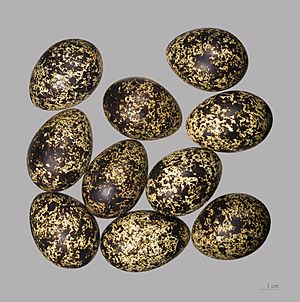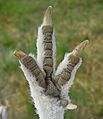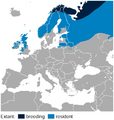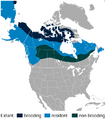Willow Grouse facts for kids
The willow grouse (called the willow ptarmigan in North America) is a medium-sized bird that belongs to the grouse family. It's known for changing its feather colors with the seasons! This bird doesn't move far from its home. It lives and raises its young in forests with birch trees and in open, treeless areas called tundra. You can find it across northern Eurasia (Europe and Asia), as well as in Alaska and northern Canada. The willow ptarmigan is even the official state bird of Alaska! Long ago, during the last ice age, these birds also lived in parts of Europe.
Quick facts for kids Willow Grouse |
|
|---|---|
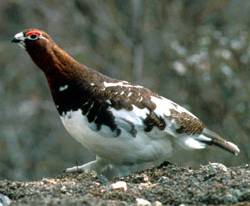 |
|
| Lagopus lagopus alascensis in autumn plumage, Lake Clark National Park | |
| Conservation status | |
| Scientific classification | |
| Kingdom: | |
| Phylum: | |
| Class: | |
| Order: | |
| Family: | |
| Genus: |
Lagopus
|
| Species: |
L. lagopus
|
| Binomial name | |
| Lagopus lagopus |
|
| Subspecies | |
|
some 10-20 including
|
|
| Synonyms | |
|
|
Contents
What is a Willow Grouse?
The willow grouse is a fascinating bird known for its amazing ability to change its feather colors. This helps it blend in with its surroundings throughout the year. It is part of the Lagopus genus, which means "hare-footed" in Greek. This name refers to its feathered feet, which act like snowshoes!
Where Do Willow Grouse Live?
Willow grouse are found in cold, northern parts of the world. They live in areas called boreal forests and tundra. These habitats include open lands with low-growing plants and forests with trees like birch and willow.
You can find them across northern Europe and Asia, including countries like Norway, Sweden, Finland, and Russia. In North America, they live in Alaska and Canada. They prefer places where they can find food and stay hidden from predators.
How Do They Change Colors?
One of the most special things about the willow grouse is its seasonal camouflage. It changes its feathers three times a year to match the changing seasons:
- In winter, their feathers are mostly white. This helps them blend in perfectly with the snow.
- In spring, as the snow melts, their feathers turn a mix of white and brown.
- By summer, they are mostly reddish-brown. This helps them hide among the plants and rocks.
This color change is very important for their survival. It helps them avoid being seen by animals that might try to hunt them, like foxes or eagles.
What Do They Eat?
Willow grouse are herbivores, meaning they eat plants. Their diet changes with the seasons, depending on what is available.
- In winter, they mainly eat twigs, buds, and catkins from trees like willow and birch.
- In summer, they enjoy eating leaves, berries, and flowers.
They have a special digestive system that helps them get nutrients from tough plant material.
Life Cycle and Reproduction
Willow grouse usually start to breed in the spring. The male grouse performs a special display to attract a female. He will fly up into the air and then glide down, making loud calls.
The female builds a nest on the ground, often hidden under a bush or in tall grass. She lays a clutch of about 6 to 10 eggs. The eggs are usually spotted, which helps them blend in with the ground.
The female does most of the incubation, which means sitting on the eggs to keep them warm until they hatch. After about three weeks, the chicks hatch. They are covered in soft downy feathers and can leave the nest very soon after hatching. Both parents help to protect the young chicks. The chicks grow quickly and are able to fly within a few weeks.
Images for kids
-
Distribution in Europe
-
Distribution in North America
See also
 In Spanish: Lagópodo común para niños
In Spanish: Lagópodo común para niños



